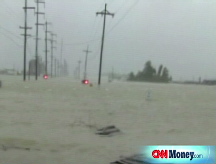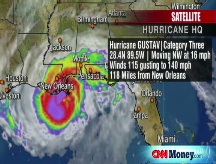1st Gulf oil rigs may be online Wednesday
Oil industry and government inspectors check platforms and refineries for damage left in the wake of the storm.
NEW YORK (CNNMoney.com) -- Oil production remained shut down in the Gulf region Tuesday, as oil companies inspected their rigs and refineries for damage, but some operations could restart as early as Wednesday.
Gustav threatened oil's infrastructure in the Gulf of Mexico with Category 3 winds, rain and waves over the holiday weekend. When it slammed into refinery-laden Louisiana Monday, it had been downgraded to Category 2. The hurricane's path steered the storm right through the heart of the region's biggest concentration of oil and gasoline producers.
"We're still in assessment mode, but so far, things are looking good," said Cathy Landry, a spokeswoman for the American Petroleum Institute. "Also, early reports are saying flooding at refineries hasn't happened, which was one of the big problems during Katrina and Rita."
In preparation for the storm, the oil industry evacuated personnel in Gustav's path, shutting down 100% of oil production in the region and cutting off or reducing capacity at 23 refineries, according to a report released Tuesday morning by the U.S. Department of Energy. Additionally, 95.4% of natural gas production was halted, and three oil delivery pipelines were closed, the report said.
Most of the shut-down infrastructure will remain non-operational until damage assessments are completed, according to the U.S. Department of Interior's Mineral Management Service agency.
As a result of the draw on oil on the market, oil refiner Citgo requested a 250,000 barrel loan from the 707 million barrel U.S. Strategic Petroleum Reserve, according to the Energy Department. The Secretary of Energy expects to reach a deal with Citgo Tuesday afternoon or early Wednesday regarding when the company will be expected to return the loan to the SPR.
Such requests are not unprecedented. In 2005, the Energy Department authorized 30 million barrels to be released from the SPR due to the drawdown on oil stockpiles from Hurricane Katrina, though oil companies only took advantage of 11 million of those barrels.
"This is a very, very small amount for Citgo to request," said Allison Austin, an Energy Department spokeswoman. "It will probably be enough to cover them for less than a week."
The Coast Guard has completed an initial flyover of the Gulf platforms and refineries using helicopters and fixed-wing aircraft, and many oil companies have done the same.
After the wake of destruction on the Gulf infrastructure left by Hurricanes Katrina and Rita in 2005, oil companies installed electronic transmitters to determine the location of their offshore platforms. According to API, contact has been established with each of the transmitters, and all are reporting that the rigs are in place. But API said that the location of the rigs cannot be confirmed until the flyovers are completed.
Oil companies said they will return workers on boats to do a more thorough assessment after their initial flyovers deem it is safe to return. Some said they could return as early as Tuesday afternoon, but it may be the end of the week before all operations are restored.
"It will take a few days to get a real sense of the damage," said Eileen Angelico, a spokeswoman for MMS.
Devon Energy Corporation (DVN, Fortune 500), which maintains 25 manned production platforms and three drilling rigs in the Gulf, said it might be able to resume production in the hurricane-stricken area by Wednesday.
"We think there's a possibility that we could get production running as early as tomorrow," said Devon spokesman Chip Minty on Tuesday. "But that really depends on the status of the pipelines we work with."
Minty said that Devon conducted reconnaissance fly-overs and did not detect any significant damage from the air. But he added that the underwater pipelines cannot be visually inspected from the air, and the company won't know if they're serviceable until on-site inspection.
The Gulf of Mexico is home to 4,000 drilling platforms and 33,000 miles of pipeline, which send 1.3 million barrels a day to the Gulf Coast's 32 refineries.
Gulf oil production accounts for 26% of total production in the United States, according to the Energy Department. The region also accounts for about 10% of the country's natural gas production.
Since Katrina and Rita, the industry began making changes to its rigs, refineries and pipelines in the region. MMS in April 2008 imposed more stringent design and assessment criteria for both new and existing structures located within particular Gulf of Mexico areas.
For example, drilling rigs moored to sea floor in the Gulf had been attached with eight lines, and are now required to be moored with 12 to 16 lines. New rigs are built higher out of the water than ones that were built previously, and old rigs were strengthened, according the American Petroleum Institute.
"Most of the older rigs were destroyed by Katrina and Rita, so what was left were mostly newer rigs," said Landry. "The new rigs are much better equipped to withstand waves, wind and rain."
And pipelines, which carry most of the oil and gas from the production platforms to the shore, now are equipped with redundant electric generation stations to ensure the power to the pumps will not be interrupted. That could help speed along the oil companies' return to operable oil production, as the Energy Department reported 49% of Louisiana customers are without electricity.
Refineries, which are susceptible to wind and flooding damage, were given structural improvements as well, as 41% of U.S. refining capacity is located on the Gulf Coast. After Katrina and Rita, 30% of Gulf Coast refineries were shut down or operating with reductions.
Similar to offshore drilling platforms, refineries are sometimes shut down for more than a week before they can return to full operability, according to API.
An experts said that the lessons learned from Katrina and Rita might mitigate the fallout of Gustav.
"The question is what the damage will be," said Esa Ramasamy, director of market reporting for energy analysis group Platts. "If there's no damage, then you'll see production to come back sooner than expected."
Home heating bills are expected to spike this winter as high gasoline prices are already straining household budgets. Are you planning to do anything different in order to reduce your heating bills? Are you cutting back on things to get by? Share your story with iReport. ![]()



